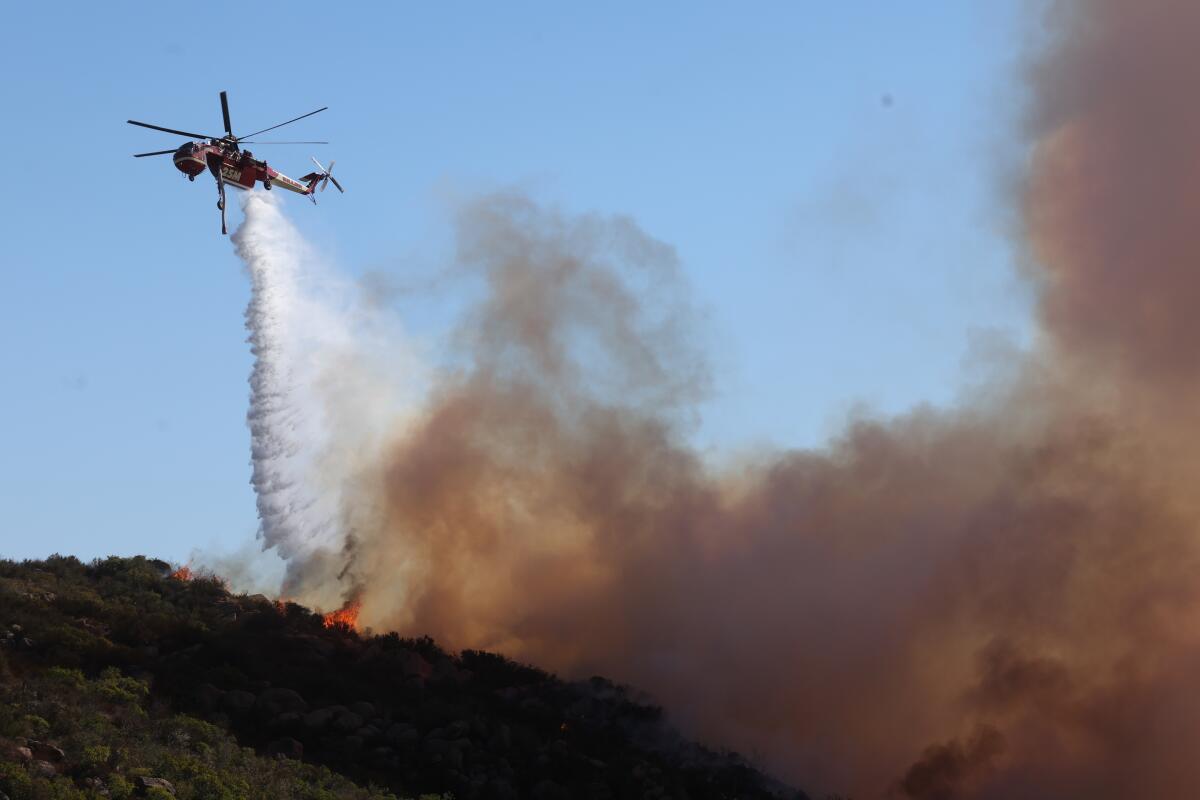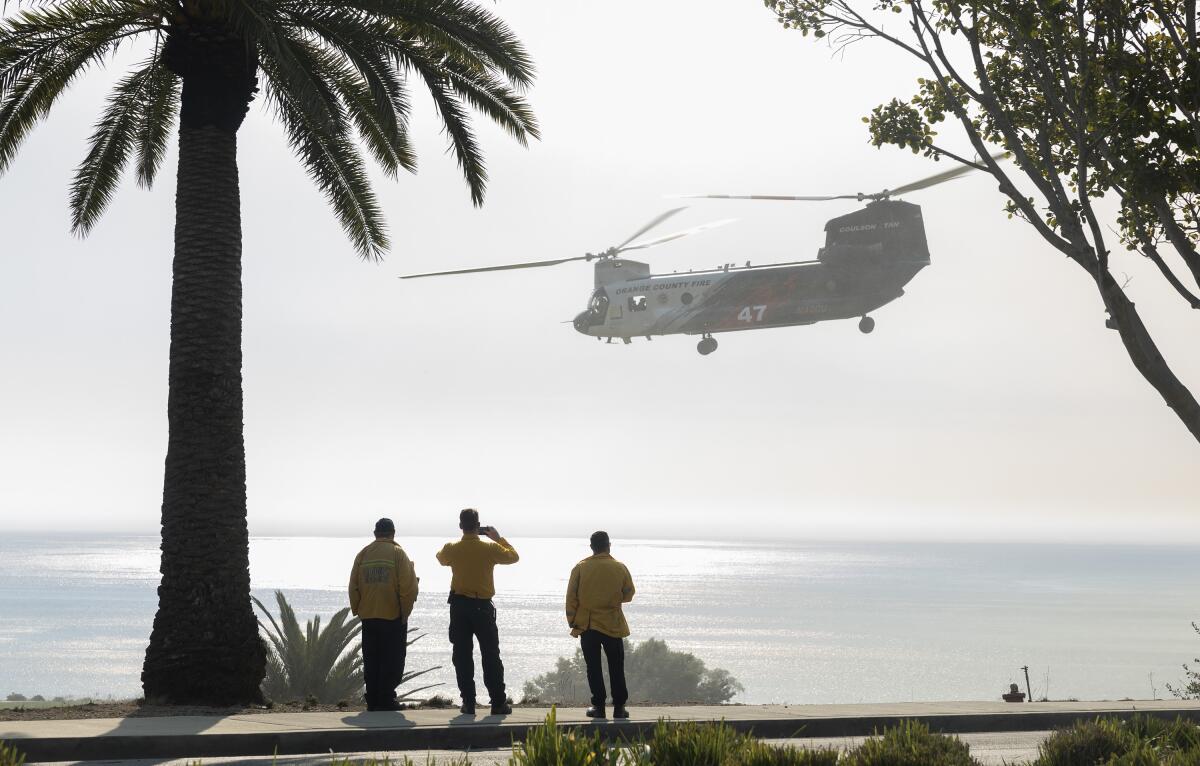Malibu is a magnet for destructive fires. But this time, it might have caught a break

- Share via
The conditions late Monday were primed for an explosive wildfire.
Forecasters had issued a rare, particularly dangerous fire weather warning across much of Southern California, as strong Santa Ana winds were expected to further dry an already parched landscape.
So when the Franklin fire broke out in Malibu on Monday night, it had the makings of a real disaster.
Malibu is one of the most fire-prone parts of Southern California, often in the path of Santa Ana winds that drive blazes marching to the Pacific Ocean.
But this time, the coastal city appears to have caught a break.

The winds eased by Tuesday afternoon and didn’t reach historic speeds. That allowed an aerial assault on the fire from planes and helicopters that officials say helped save homes.
The location of the fire not far from the ocean also minimized space for the blaze to grow.
Although Malibu isn’t out of the danger zone, property damage has been reported as moderate and no major injuries were reported. That is a marked contrast from some destructive fires to hit the region in recent years.
Last month’s Mountain fire in Ventura County, as well as the massive Thomas and Woolsey fires, exploded with monster winds that pushed flames for miles and grounded firefighting aircraft.
By Tuesday afternoon, the Franklin fire had grown to an estimated 2,700 acres, with widespread evacuations still in place. The National Weather Service reported sustained winds of up to 45 mph and gusts up to 65 mph around the fire, but the worst of the winds — which tend to be the driving factor of these dangerous, late-season fires — have passed.
“For the most part, … we’ll be seeing those [winds] decreasing,” said Mike Wofford, a National Weather Service meteorologist in Oxnard. “It should be considerably less tomorrow.”
Although there were winds in the greater area that topped 80 or 90 mph late Monday and into Tuesday, speeds around the Franklin fire were significantly lower, Wofford said. That wasn’t the case in the Mountain fire last month, which recorded hurricane-force winds over the fire, pushing embers more than two miles away from the main fire line.

“The situation there at the Mountain fire was different meteorologically because that area is more susceptible to these east winds,” Wofford said. He said the location of the Franklin fire on the eastern side of the Santa Monica Mountains probably helped reduce wind speeds. If the fire had instead sparked in the western Santa Monicas — the location of the Woolsey fire — he expects the fire could have been much worse.
“Santa Ana winds tend to be more easterly winds, so the western part of Santa Monicas get hit more” Wofford said, explaining how they tend to blow from the Santa Clarita area through the mountain passes. He said the area between the Santa Monica and Santa Susanna mountains is a corridor more exposed to those dangerous winds.
Less dramatic winds also aided the initial response to the firefight, enabling helicopters with night-vision capabilities to fly most of the night during the first hours of the Franklin fire and direct crews to the most urgent areas to attack. By daybreak, two larger air tankers, known as SuperScoopers, were also able join the operation, officials said.
“There’s a lot of geographical features, canyons, drainages, paired with, you know, those strong winds. All that, all those factors can come into alignment and make for some very hazardous fire conditions. So we’re working as hard as we can,” said L.A. County Fire Captain Kealiinohopono Barnes.
There was only a brief period around 3 a.m. when aircraft were grounded due to extreme winds, but the rest of the night they were “able to operate even with heavy winds,” said Los Angeles County Fire Chief Anthony Marrone.

In the first hours of the Mountain fire last month, winds kept most aircraft grounded longer, though helicopters were still able to help, said Ventura County Fire spokesperson Andrew Dowd.
But any advantage firefighters may have on the Franklin fire compared to prior blazes has not stopped an extensive ground and air attack, officials said. Massive helicopters buzzed around Pepperdine University on Tuesday, one dipping down into a lagoon to suck up water before heading for an immense plume of smoke in the distance.
“We are going to have a coordinated air and ground assault on this fire for as long as it takes,” Marrone said. “Time is of the essence for us to grab hold of the fire and start getting containment.”
Although conditions in Malibu may not be among the worst firefighters have seen, the Franklin fire has torched several vehicles and left residents who had to flee terrified. Damage to structures is still being assessed.
Jessica Jones and Matthew Ryder grabbed their essentials before the Franklin fire made its way to their home in Serra Retreat: Important documents. Bags of clothes. Three goats. A potbellied pig.
The fire reached the property as the couple left around midnight, and they waited on the side of the Pacific Coast Highway to plan where to go next. They slept in their truck in a parking lot for hiking trails and arrived at the Palisades Park evacuation center around 6:30 a.m. Tuesday.
“It was insane,” Jones said. “The bright red flames and glow of the fire were all around the ridgeline as we were leaving.”
Times staff writers Richard Winton and Joseph Serna contributed to this report.
More to Read
Sign up for Essential California
The most important California stories and recommendations in your inbox every morning.
You may occasionally receive promotional content from the Los Angeles Times.












